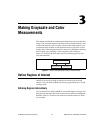Chapter 2 Getting Measurement-Ready Images
IMAQ Vision for Visual Basic User Manual 2-10 ni.com
Highpass filters emphasize details, such as edges, object boundaries,
or cracks. These details represent sharp transitions in intensity value.
You can define your own highpass filter with
CWIMAQVision.Convolute
or
CWIMAQVision.NthOrder, or you can use a predefined highpass
filter with
CWIMAQVision.EdgeFilter or
CWIMAQVision.CannyEdgeFilter. CWIMAQVision.EdgeFilter
allows you to find edges in an image using predefined edge detection
kernels, such as the Sobel, Prewitt, and Roberts kernels.
Convolution Filter
CWIMAQVision.Convolute allows you to use a predefined set of
lowpass and highpass filters. Each filter is defined by a kernel of
coefficients. Use the CWIMAQKernel object to define the filter. Use
CWIMAQKernel.LoadKernel to load a predefined kernel into the
object. If the predefined kernels do not meet your needs, use the
CWIMAQKernel.SetSize method to set the size of the kernel and the
CWIMAQKernel.Element property to set the data in the kernel.
Nth Order Filter
CWIMAQVision.NthOrder allows you to define a lowpass or highpass
filter depending on the value of N that you choose. One specific Nth order
filter, the median filter, removes speckle noise, which appears as small
black and white dots. For more information about Nth order filters, refer to
Chapter 5, Image Processing, of the IMAQ Vision Concepts Manual.
Grayscale Morphology
Perform grayscale morphology when you want to filter grayscale
features of an image. Grayscale morphology helps you remove or
enhance isolated features, such as bright pixels on a dark background.
Use these transformations on a grayscale image to enhance non-distinct
features before thresholding the image in preparation for particle analysis.
Grayscale morphological transformations, which include erosions and
dilations, compare a pixel to those pixels that surround it. An erosion keeps
the smallest pixel values. A dilation keeps the largest pixel values.
For more information about grayscale morphology transformations, refer
to Chapter 5, Image Processing, of the IMAQ Vision Concepts Manual.


















